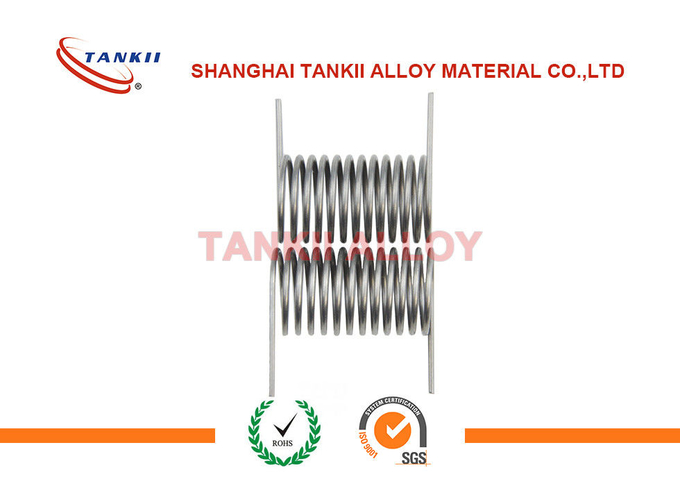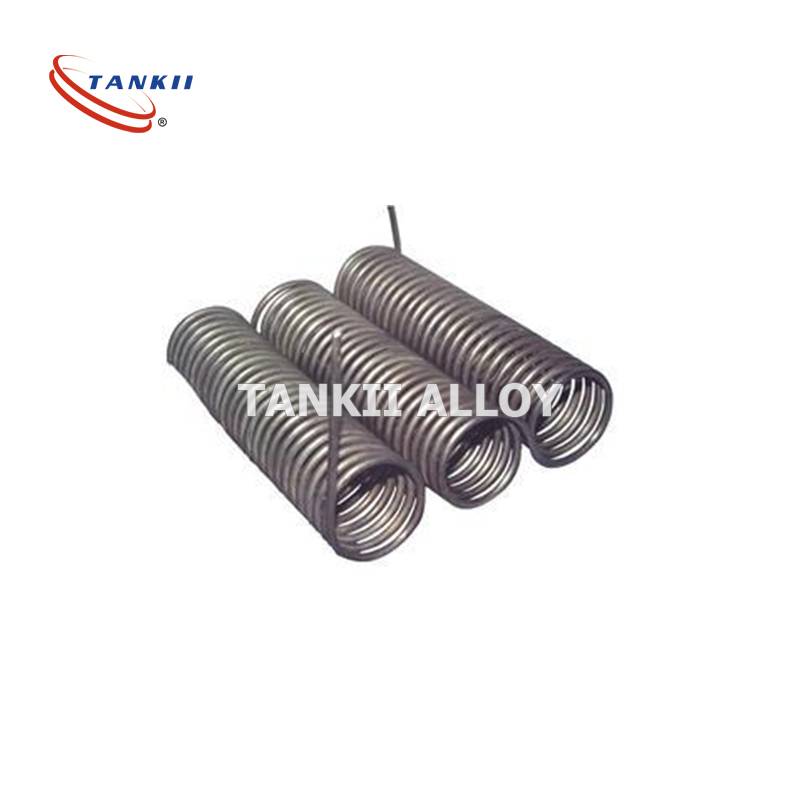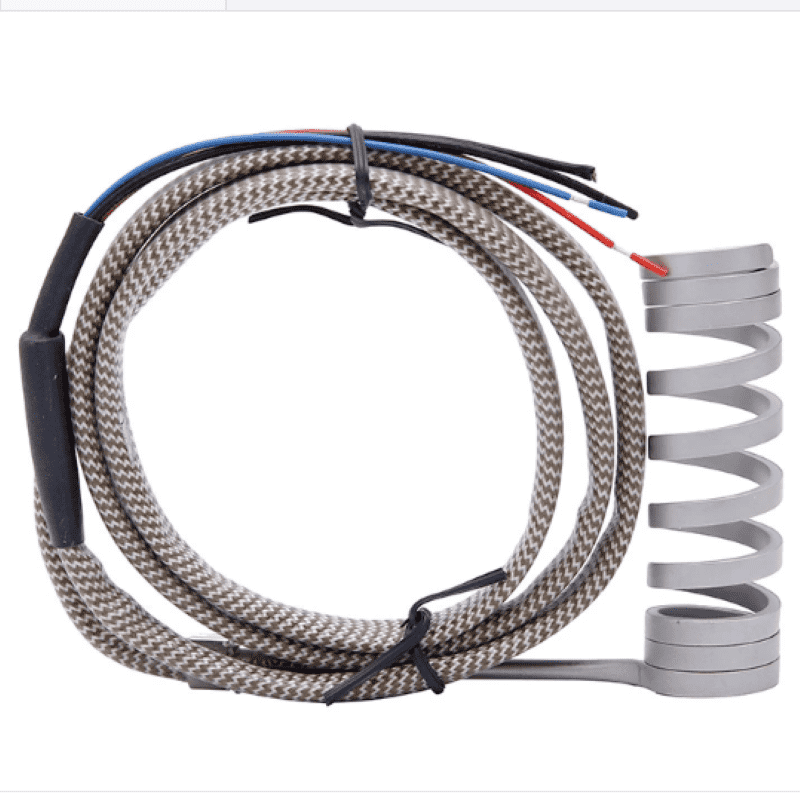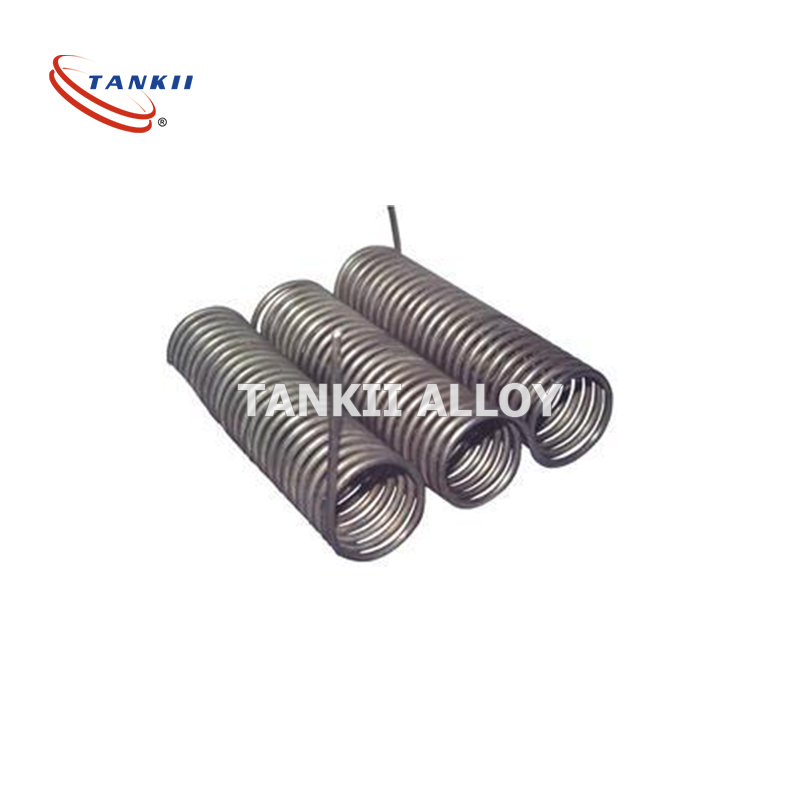Spiral Electric Resistor Nicr Alloy 1 – 5 Mohm For Air Conditioner Heating Elements
Spiral Electric Resistor Nicr Alloy 1 – 5 Mohm For Air Conditioner Heating Elements
1.Material General Description
Constantan is a copper-nickel alloy also known as Eureka, Advance, and Ferry. It usually consists of 55% copper and 45% nickel. Its main feature is its resistivity, which is constant over a wide range of temperatures. Other alloys with similarly low temperature coefficients are known, such as manganin (Cu86Mn12Ni2).
For the measurement of very large strains, 5% (50 000 microstrian) or above, annealed constantan (P alloy) is the grid material normally selected. Constantan in this form is very ductile; and, in gauge lengths of 0.125 inches (3.2 mm) and longer, can be strained to >20%. It should be borne in mind, however, that under high cyclic strains the P alloy will exhibit some permanent resistivity change with each cycle, and cause a corresponding zero shift in the strain gauge. Because of this characteristic, and the tendency for premature grid failure with repeated straining, P alloy is not ordinarily recommended for cyclic strain applications. P alloy is available with S-T-C numbers of 08 and 40 for use on metals and plastics, respectively.
2. Spring Introduction and applications
A spiral torsion spring, or hairspring, in an alarm clock.
A volute spring. Under compression the coils slide over each other, so affording longer travel.
Vertical volute springs of Stuart tank
Tension springs in a folded line reverberation device.
A torsion bar twisted under load
Leaf spring on a truck
Springs can be classified depending on how the load force is applied to them:
Tension/extension spring – the spring is designed to operate with a tension load, so the spring stretches as the load is applied to it.
Compression spring – is designed to operate with a compression load, so the spring gets shorter as the load is applied to it.
Torsion spring – unlike the above types in which the load is an axial force, the load applied to a torsion spring is a torque or twisting force, and the end of the spring rotates through an angle as the load is applied.
Constant spring – supported load remains the same throughout deflection cycle.
Variable spring – resistance of the coil to load varies during compression.
Variable stiffness spring – resistance of the coil to load can be dynamically varied for example by the control system,some types of these springs also vary their length thereby providing actuation capability as well.
They can also be classified based on their shape:
Flat spring – this type is made of a flat spring steel.
Machined spring – this type of spring is manufactured by machining bar stock with a lathe and/or milling operation rather than a coiling operation. Since it is machined, the spring may incorporate features in addition to the elastic element. Machined springs can be made in the typical load cases of compression/extension, torsion, etc.
Serpentine spring – a zig-zag of thick wire – often used in modern upholstery/furniture.
3.Chemical Composition and Main Property of Cu-Ni Low Resistance Alloy
| PropertiesGrade | CuNi1 | CuNi2 | CuNi6 | CuNi8 | CuMn3 | CuNi10 | |
| Main Chemical Composition | Ni | 1 | 2 | 6 | 8 | _ | 10 |
| Mn | _ | _ | _ | _ | 3 | _ | |
| Cu | Bal | Bal | Bal | Bal | Bal | Bal | |
| Max Continuous Service Temperature(oC) | 200 | 200 | 200 | 250 | 200 | 250 | |
| Resisivity at 20oC (Ωmm2/m) | 0.03 | 0.05 | 0.10 | 0.12 | 0.12 | 0.15 | |
| Density(g/cm3) | 8.9 | 8.9 | 8.9 | 8.9 | 8.8 | 8.9 | |
| Thermal Conductivity(α×10-6/oC) | <100 | <120 | <60 | <57 | <38 | <50 | |
| Tensile Strength(Mpa) | ≥210 | ≥220 | ≥250 | ≥270 | ≥290 | ≥290 | |
| EMF vs Cu(μV/oC)(0~100oC) | -8 | -12 | -12 | -22 | _ | -25 | |
| Approximate Melting Point( oC) | 1085 | 1090 | 1095 | 1097 | 1050 | 1100 | |
| Micrographic Structure | austenite | austenite | austenite | austenite | austenite | austenite | |
| Magnetic Property | non | non | non | non | non | non | |
| PropertiesGrade | CuNi14 | CuNi19 | CuNi23 | CuNi30 | CuNi34 | CuNi44 | |
| Main Chemical Composition | Ni | 14 | 19 | 23 | 30 | 34 | 44 |
| Mn | 0.3 | 0.5 | 0.5 | 1.0 | 1.0 | 1.0 | |
| Cu | Bal | Bal | Bal | Bal | Bal | Bal | |
| Max Continuous Service Temperature(oC) | 300 | 300 | 300 | 350 | 350 | 400 | |
| Resisivity at 20oC (Ωmm2/m) | 0.20 | 0.25 | 0.30 | 0.35 | 0.40 | 0.49 | |
| Density(g/cm3) | 8.9 | 8.9 | 8.9 | 8.9 | 8.9 | 8.9 | |
| Thermal Conductivity(α×10-6/oC) | <30 | <25 | <16 | <10 | <0 | <-6 | |
| Tensile Strength(Mpa) | ≥310 | ≥340 | ≥350 | ≥400 | ≥400 | ≥420 | |
| EMF vs Cu(μV/oC)(0~100oC) | -28 | -32 | -34 | -37 | -39 | -43 | |
| Approximate Melting Point( oC) | 1115 | 1135 | 1150 | 1170 | 1180 | 1280 | |
| Micrographic Structure | austenite | austenite | austenite | austenite | austenite | austenite | |
| Magnetic Property | non | non | non | non | non | non | |
















